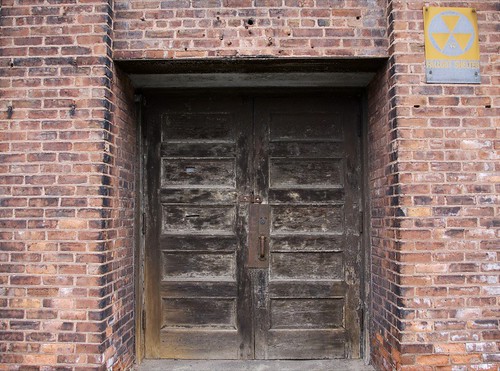 |
| I took this photo in Jersey City on September 15, 2007. Notice the "Fallout Shelter" sign at the upper right. This building, now destroyed, was near the Holland Tunnel entrance/exit. |
Every now and then I'll talk about growing up in the 1950s and how I even thought about just where to place the family fallout shelter. That was the height of the Cold War and the possibility of getting bombed to kingdom-come seemed real. Well, I war cruising the web, making my rounds, and came across a link to and old issue of Popular Mechanics. Seems that the good folks a Google have a whole bunch of them just sitting out there in the web. So I did a search on "fallout shelter" and bingo! up popped a bunch of articles. Just follow the link and look at those articles. You'll find everything you need to build your own fallout shelter.
☢
A bomb is dropped on a key target. But who cares, you live lies away. Fallout can't reach you. but soon you and your family become ill, dangerously ill. Now you wish you had heeded the importance of a family fallout shelter. If you decide to build one, first consult your local building code and the Civil Defense authorities.
☢
Here's an article about fallout shelters in New York City back in the 1950s and 1960s:
Decades after the end of the Cold War, ominous black-and-yellow fallout shelter signs still mark buildings across New York City’s five boroughs. The actual number of designated fallout shelters in the city is difficult to discern. What is known is that by 1963, an estimated 18,000 shelters had been designated, and the Department of Defense had plans to add another 34,000 shelters citywide.While the presence of a fallout shelter in one’s building may have given some residents peace of mind in an era when nuclear destruction seemed imminent, in reality, most of New York’s fallout shelters were little more than basements marked by an official government sign.A small percentage of shelters were fortified underground bunkers stocked with emergency supplies, but these were rare and primarily built for high-ranking government officials. The majority of shelters, including nearly all those that were visibly marked, were known as “community shelters,” and by all accounts, they offered little special protection. Inspector guidelines simply indicated that “community shelters” should be kept free of trash and debris and have a ventilation system that can provide a “safe and tolerable environment for a specified shelter occupancy time.” Regulations for the ventilation systems appeared to be open to interpretation, leaving individual inspectors to determine which of the city’s windowless basements would ultimately make the cut.
Riverside grocery store hd a raffle for a fallout shelter. Remember those days very well. Sirens blasting!
ReplyDeleteI had one friend whose family had a fallout shelter in the basement when I was a child. We used to use it for sleepovers.
ReplyDeleteThat makes sense. That's what they're for, right? I mean, I was just a child in the 50s and "cool sleepover" is what fallout shelters meant. I read "Mechanix Illustrate", "Popular Mechanics", and "Popular Science" and all of them had articles on the home fallout shelter and sometimes complete plans. It seems that Google has digitized a run of "Popular Mechanics" and if you search it on "fallout shelter" the articles show up. You can find a link at the beginning of the orange paragraph.
Delete